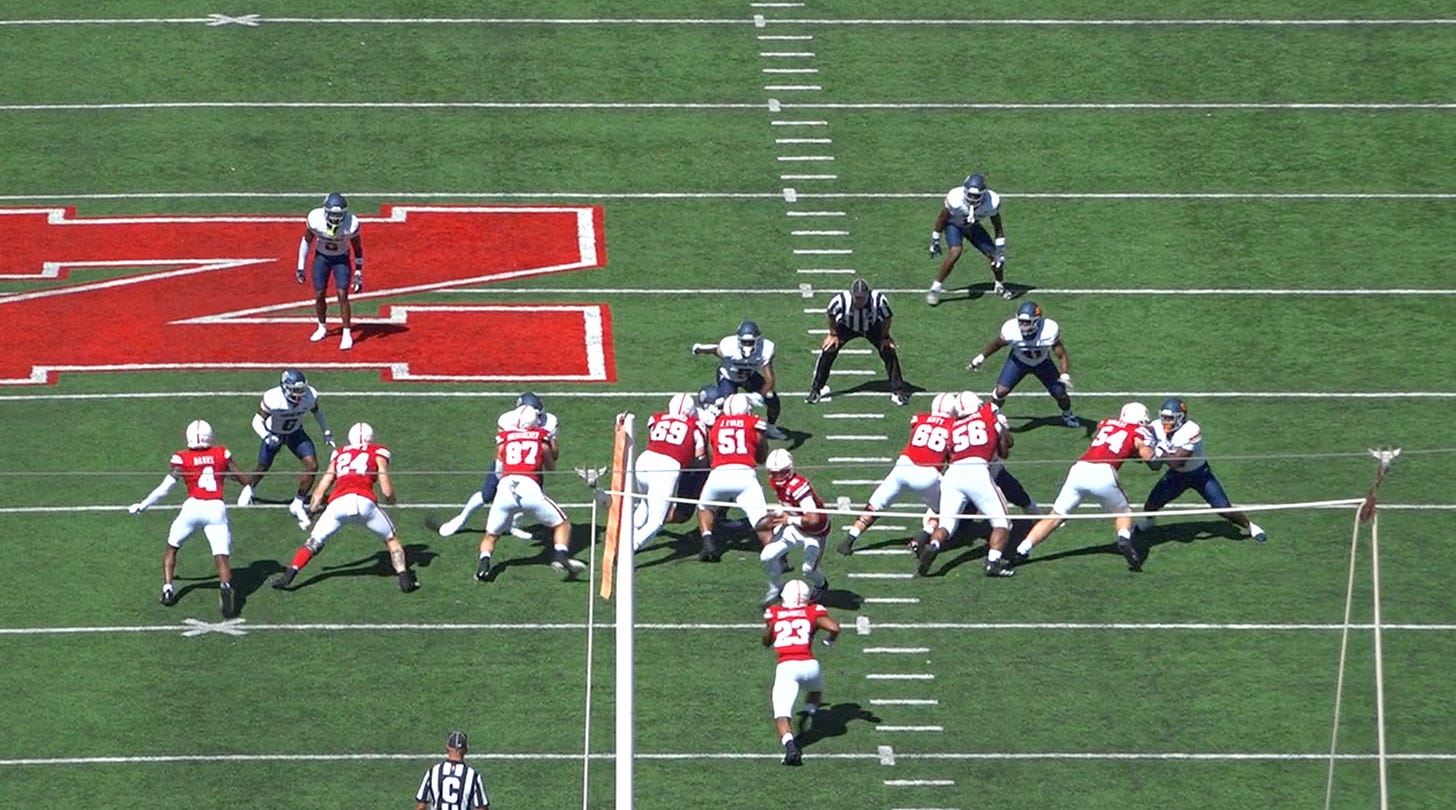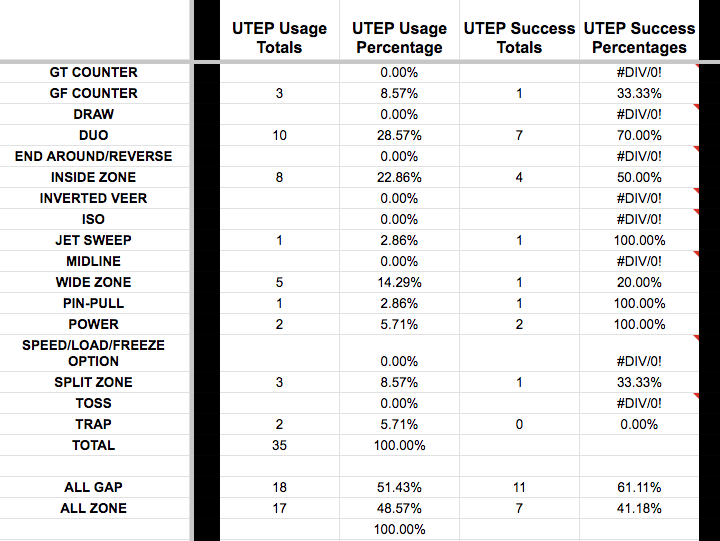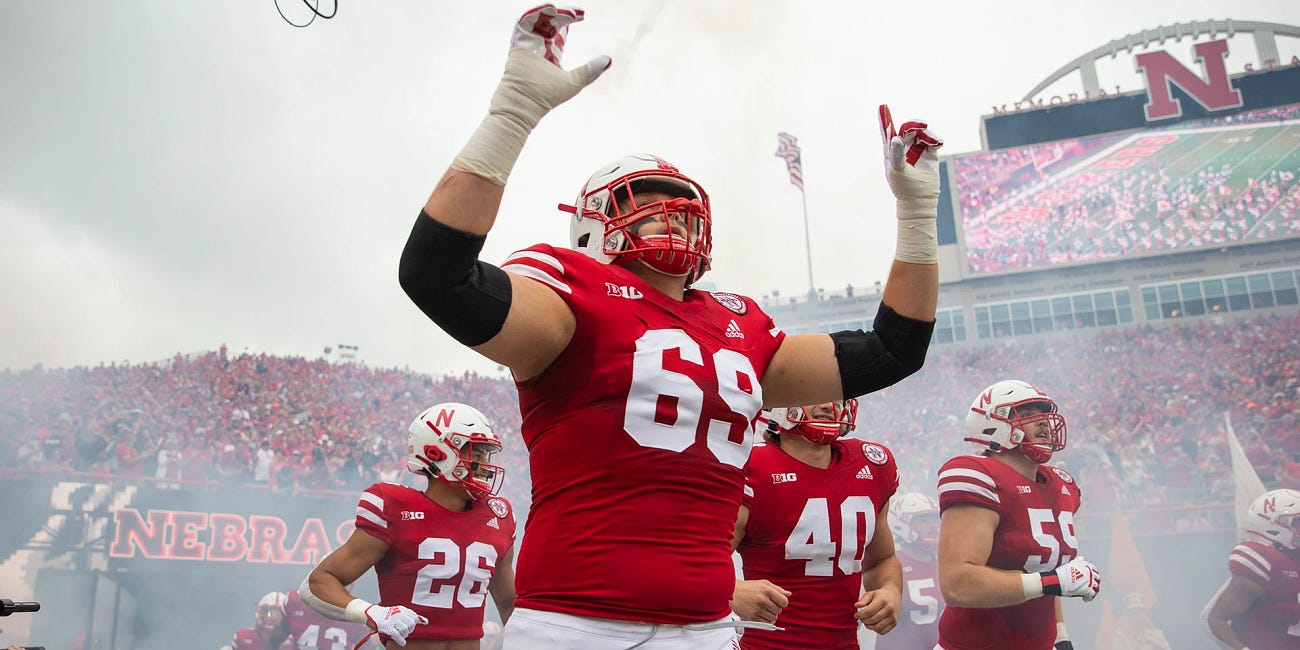It’s hard to overstate just how much better every element of the offense was against UTEP on Saturday than it was at any point last season.
Every metric I chart or care about for determining who wins a football game was improved for the offense in Week 1,1 most significantly so:
Success Rate: 52.4% (36.7% last season)
Yards Per Play: 7.1 (5.8)
Explosive Play Rate: 11.9% (9.3%)
Havoc Play Allowed Rate: 5.1% (14.4%)
First Down Success Rate: 46.2% (35.5%)
Third/Fourth Down Conversion Rate: 71.4% (38.8%)
Passing Downs Success Rate: 57.1% (22.8%)
Third/Fourth Short Conversion Rate: 83.3% (68.8%)
Everything is better here, but from a “general appearance of competency” standpoint for the offense — going from a unit in 2023 that routinely seemed disjointed, made mistakes, and could only move the ball by hitting big plays to one that was organized, in-sync, and professional — the two that stand out the most are the havoc play rate and the passing down rate.
A “havoc” play is essentially any negative play caused by the defense: a tackle for loss, sack, batted/tipped pass, interception, fumble, or lost snap. Nebraska on Saturday cut how often it was allowing those negative havoc plays by almost two thirds, from 14% to 5%. NU’s starters only suffered three havoc plays in 59 snaps.
A passing down is any second-and-8 or longer or third- or fourth-and-5 or longer — essentially any play where the defense knows you’re going to pass. If Nebraska got in those situations last year, the drive was basically over: It was successful on less than a quarter of those situations last season. But Saturday, it was successful almost 60% of the time. You can call that the Dylan Raiola Effect.
Nebraska’s five-star freshman quarterback had some ups-and-downs on a closer film inspection (there’s a more detailed section on that later), but he showed an exciting ability to create plays as a passer the Nebraska football program has never seen in its history, and process-wise he was a significant upgrade to any of the 2023 quarterbacks on his ability to just hit the top of a dropback and get an accurate ball out. I don’t expect him to keep up that high of a success rate in determined passing situations, but just having basic competence in the dropback game helped the offense out a lot Saturday, and it should continue.
Those two elements — NU not shooting itself in the foot as often and not being dead in the water in passing situations — did a lot of the heavy lifting for the offensive improvement. But the whole operation just seemed more organized and talented. Nebraska’s offensive line blew a smaller front off the ball, something that hasn’t always happened. Its receivers won routes with both physicality and speed and made clear the difference between a Big Ten skill player and a corner from a lower conference. Its running backs hit holes at full speed and broke tackles in space. Nebraska had a physical advantage and used it.
That domination was already happening on defense and continued. Nebraska’s starting defense had a 72.4% success rate and generated a havoc play of its own on 27.6% of its snaps. They were, essentially, forcing UTEP into a negative play every third snap. It’s hard to get better than that.
The performance on both sides of the ball was also impressive because NU seemed to not be using every club in its bag. On offense, outside of one goalline Wildcat play with Heinrich Haarberg, Nebraska used no specialty formations Saturday, and it didn’t build many “plays off of plays.” On defense, it brought few rushers or exotic pressure packages and stayed in basic zone coverage shells the whole game. On both sides of the ball, NU stayed in base looks and used base plays with little window dressing —probably not that different than what you’d still get in the spring game — and trusted it had better players who could bully a smaller, less athletic team.
The obvious caveat here is that this performance came against one Conference USA school with a new coach. Tougher opponents on both sides of the ball are ahead. But even last year in Nebraska’s two “buy” games, against Northern Illinois and Louisiana Tech, their numbers on offense were only slight improvements on the bad 2023 season averages listed above. Nebraska was playing a bad defense Saturday, but last year it wasn’t dominating against bad defenses. For at least one game of 2024, it pushed a lesser team around to complement its bully ball on defense.
PROGRAMMING NOTE: Apologies for this getting out later in the week. The first time charting each season always takes longer than others as I’m figuring out the best way to look at things (and then I also had an emergency pop up at my day job over the weekend). My goal is to get the post out earlier in the week, possibly on Wednesdays, but bear with me: There’s a lot of elements to chart here and I’m doing this in my free time. But future posts will likely/hopefully be out sooner.
I’m trying a different format for the recaps this year. Instead of going drive-by-drive, I’m instead going to just each week hit on points I found interesting or different from game-to-game, plus a couple recurring special sections. I went a bit long here since it was Week 1 and there was a lot to discuss. This week’s sections are:
A DOMINANT LINE
DEFENSIVE GAMEPLAN
CHARTING RAIOLA
RPO NUMBERS RISE
QUADS?
DEEP CURLS
BOX COUNT
UNSUNG PLAY OF THE WEEK
TURNOVER-MARGIN TRACKER
A DOMINANT LINE
In a game with an exciting young quarterback making a bunch of cool throws and a new group of receivers scoring long touchdowns, it makes me sound like an old-head to be like, “The offensive line was the real star!” But I’m going to do it anyway.
Saturday was one of the best run-blocking performances by a NU offensive line in some time. Probably since Scott Frost’s first season in 2018, or possibly back to Bo Pelini.
The line showed a greatly improved cohesion and explosiveness of the ball that it didn’t have last year. Nebraska was a solid rushing team last year, and has had some good run-blocking units in recent years, but throughout that period the rushing production has been greatly helped by big-play runs or quarterback carries; the down-to-down operation of the line hasn’t always been good. There have been a lot of snaps in the last seven years where a lineman was getting pushed backwards, or allowing penetration, or messing up a split, or tangling feet and falling over.
But Saturday they looked powerful, athletic, and moved as one. This is from one Duo rep Saturday right after the snap:
Every player here is in the teaching-tape right spot, playing with balance and pushing their defender forward with a good base. No one is way out over their skis. No one is falling backwards or way overextended forward. The two double teams are well executed and pushing their defender off the ball, with one of the lineman in each double team in position to get to the second level to block up the linebackers and account for everyone in the run fit.
Here’s video of a different rep of the same concept:
Same thing: Everyone, even the tight ends, moving in concert and functioning as a wall. This time UTEP brings two second-level players on inside blitzes. Left guard Justin Evans has his eyes up and comes off his combo block to stuff the blitzer and keep the back clean to cut and hit a seam.
NU ran Duo, an inside-hitting run with two double teams, 10 times on Saturday, with seven of them successful plays. It ran Inside Zone, another interior run, eight more times and had a successful play on four of those. That’s elite production for A and B gap runs. Last year, those plays were successful 47% and 33% of the time. Both are big improvements, even against a bad front.
They executed beyond just interior runs, too, hitting a variety of concepts even in a vanilla gameplan. This was a chart of all the plays Nebraska ran Saturday with a run element included and how successful they were. The two columns to the left are how often each concept was used, and the two columns to the right are how often they were successful:
That’s nine distinct run concepts Nebraska used.
Here are a couple blocking reps of outside run concepts off run-pass options, the first a pin-pull play and the second an outside zone look:
Again, look at the level of combined execution on the unit here. Not only are the individual blocks effective, but the unit as a whole is moving with cohesion and executing complex assignments together to create an alley in the correct gap.
Look specifically at the pin-pull play. Tight end Thomas Fidone executes an initial contact with the edge defender, throws the edge defender inside him to be taken by the puller and gets to the second-level backer, and the puller (Evans) IDs the edge Fidone contacted and knocks him backwards to create the alley for the run. All in about the span of a second.
That’s five well-coached players operating together in a blink in space. They’ll face tougher fronts in the future, but this level of execution will carry over to better opponents.
DEFENSIVE GAMEPLAN
The defense only saw the field for 29 non-garbage-time plays Saturday, so I have less to say about them this week. But there were some takeaways and interesting things going on.
There was some mild pre-game concern that UTEP’s super-spread, super-tempo, super-motion offense would stress Nebraska’s defense and be able to put up a few touchdowns. I wrote before kickoff about NU’s struggles with optionality toward the end of last season:
It still looked concerning after the Miners’ second drive, when UTEP’s three plays, all run-pass options, went 12 yards, 13 yards, and 37 yards to score quickly to tie the game.
But other than that three-play sequence that was largely just new safety Malcolm Hartzog making three consecutive mistakes, NU’s defense rolled, with an 80.8% success rate (!!) on the other 26 plays, generating all eight of its havoc plays in those snaps, including a safety and an interception, and allowing no explosives and just 2.3 yards per play.
Overall, Nebraska forced a havoc play on 27.6% of its snaps (also a !!!) and forced UTEP into an average third down of 11.8 yards to go. UTEP didn’t attempt a third down shorter than 5 yards. That’s insanely good stuff.
What was the gameplan?
Coordinator Tony White chose to defend UTEP with very few rushers, lots of deep safeties, and zone coverage:
NU brought three rushers on 48.3% of the starters’ snaps and four rushers on the other 51.7% of its snaps; it didn’t have a play with the first or second unit where it brought more than four rushers. Those rates last year were 16.6% for three-player rush and 39.9% for the four-player rush.
He also used a limited amount of stunts (only three for the starters’ snaps), and only used one “pressure package” front — or designer-type look meant to rush the passer. He did bring a blitz on seven of the starters’ snaps, but they were all single A or B gap blitzes out of three-player fronts, meaning there were only four total rushers. He exclusively trusted a vanilla three- and four-player rush to win the whole game.
He brought so few because (A) Nebraska was obliterating the line of scrimmage with only three- and four-player rushes, and (B) because UTEP’s quick-passing and RPO offense was getting the ball out of the quarterback’s hands so fast. You could see something similar this week against Colorado.
White started with all three of his safeties deep on a majority of the starters’ snaps, and then rotated into different coverage shells from there.
Last year, Nebraska played with all three safeties deep on only 11% of snaps; Saturday it was at 55.2%. NU rotated coverage (giving the appearance of one coverage shell before moving to a different one after the snap) on 28.1% of snaps last season and was at a whopping 75.9% against UTEP. Rover Isaac Gifford didn’t spend a single play in the box Saturday.
I’d guess the deep shell rate was that high because White wanted to provide a security blanket with UTEP trying to operate in so much space. The idea of UTEP’s offense is to get skill players the ball one-on-one in extreme horizontal splits, where one missed tackle can lead to a chunk gain. Having three safeties deep over the top of everything is just a second level of protection to prevent one of those going 70 yards.
I also think the rotation rate was meant to discourage UTEP pre-snap from pulling the ball on its RPOs. A lot of its plays are run-pass options designed to look at safety alignment over the top pre-snap, with the quarterback having the ability to pull the ball to throw deep into one-on-one coverage if they get a single-high shell. With Nebraska starting with three-deep (or even two deep), it was encouraging the offense to hand the ball off — and then you can rotate into the coverage you actually want to run after the snap.
White played exclusively zone coverage Saturday, with not a single snap of man. The play where Hartzog got beat for a touchdown looked like man coverage but was actually a “lock” based on zone coverage rules.
Of the zone coverages Cover 2 Tampa was 55% of NU’s plays, with about 24% Cover 3 and 17% Cover 6 and a few snaps of Cover 4 mixed in. Cover 6 is a concept with Cover 2 to one side and Cover 4 to the other, which means NU was running Cover 2 to at least one side of the field on almost 72% of its plays. That was at about 18% last year.
The idea there was, I imagine, the same as with the deep safeties: Providing help and making the success of the defense not on single players in man coverage. It’s easier to rally to the ball in zone, and it lets your defenders keep their eyes on the field instead of just on the player they’re covering.
Still, pretty radical: I’ve never seen a game where a team played zero man coverage whatsoever. I don’t think you can play all zone against Shedeur Sanders next week and not give up a ton of passing yards, but it worked against UTEP.
There was one adjustment White made I noticed. When NU was in three-player fronts, the Miners were often just not blocking the weak-side end in the front and reading him or sending a puller at him.
On about the fourth drive, White had that weakside end widen out from the rest of the front and turn at an angle to the quarterback, which gave the end a better angle to penetrate the backfield and let them get a running start back to the mesh point of the play between the quarterback and back. It looked like this, toward the right side of the screen:
The first time NU used this alignment was on the play that resulted in the safety, with Ty Robinson going wide and angled, attacking the mesh point fast, and forcing the weird exchange that the rest of the defense cleaned up for two points and the ball. It also generated a later 5-yard loss TFL for Robinson in the third quarter.
I’m not sure why UTEP thought leaving the edge unblocked was a good idea, but it backfired.
CHARTING RAIOLA
Despite it being probably the biggest storyline this offseason, I held off on evaluating Raiola, aside from just an overview of what similar-stature recruits have done in their first years as starters, because I didn’t really think we had anything real to look at and judge how he might do.
Now that he’s played real snaps against a college defense, I think we can actually start making meaningful observations about his performance.
One of the things I added to charting this year was evaluating the quarterbacks’ decision-making and accuracy. I don’t have NU’s playbook or coaching points to fully evaluate decision-making, but I think we can tell a lot from generally accepted progressions on concepts and coverage reads, and we can judge ball-placement and footwork, too.
Keep reading with a 7-day free trial
Subscribe to Black 41 Flash Reverse to keep reading this post and get 7 days of free access to the full post archives.







